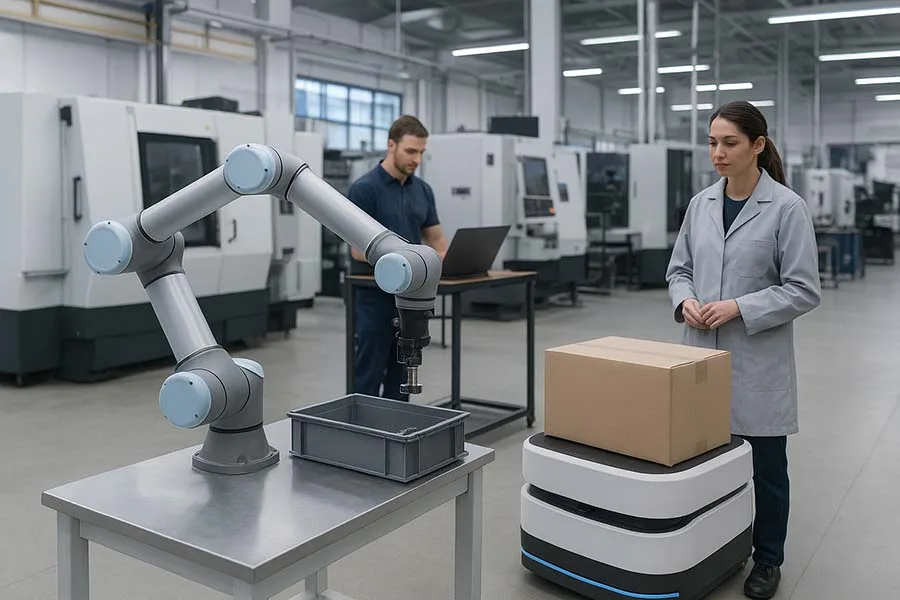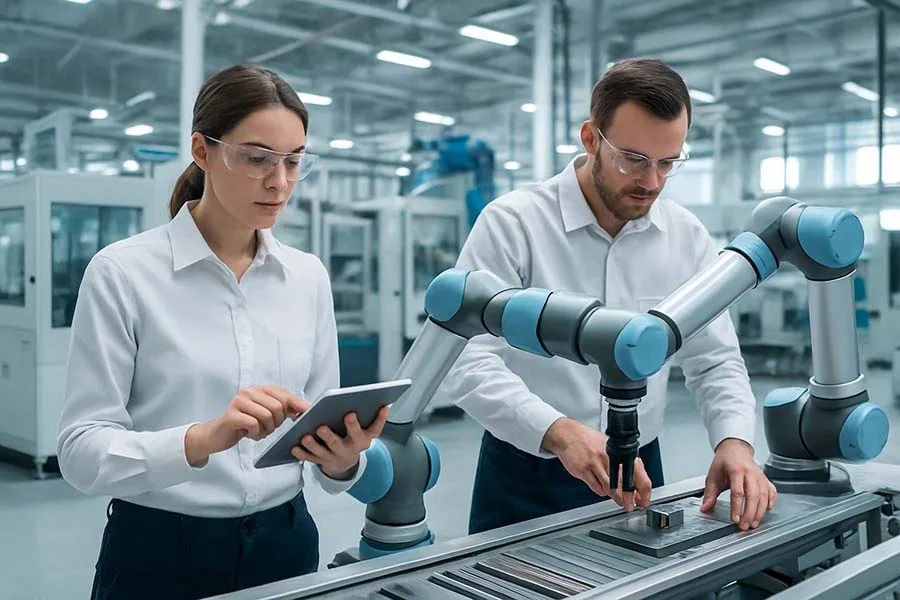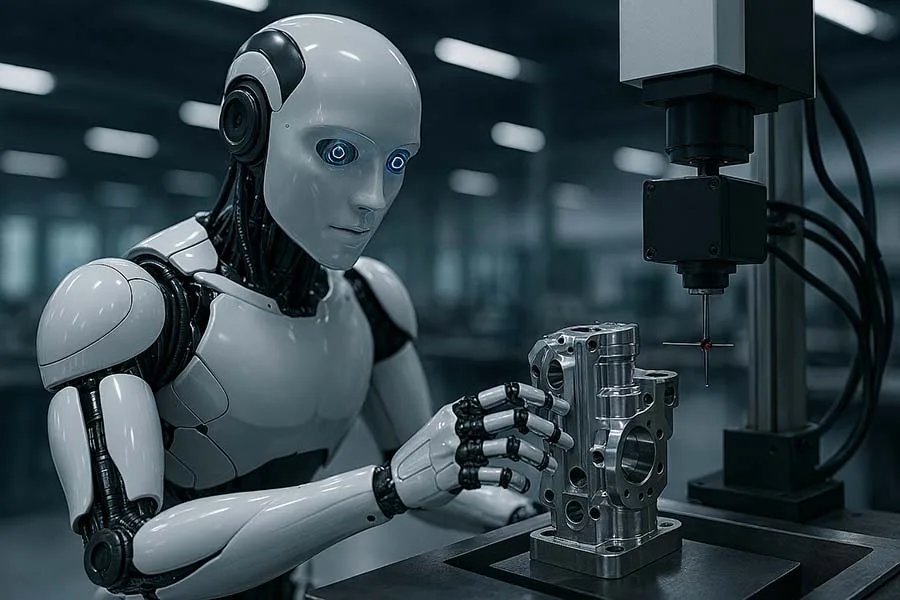Introduction: Small Shops, Big Questions
When most people think of robots in manufacturing, they picture giant automotive factories filled with robotic arms welding car frames at lightning speed. But what about the small and medium enterprises (SMEs) that make up the majority of global manufacturing? Many shop owners still believe robotics is “too big,” “too expensive,” or “too complex” for their scale.
Here’s the good news: those assumptions are outdated. Today, robotics is no longer an exclusive club for Fortune 500 manufacturers. The reality is that SMEs can deploy robotics affordably, flexibly, and profitably. Let’s break down the myths and reveal how automation is reshaping the shop floor for small and medium manufacturers.
Myth #1: “Robots Are Too Expensive for SMEs”
The myth: Robotics means millions in upfront investment.
The reality: Robotics prices have dropped dramatically, and financing models make them accessible.
- Collaborative robots (cobots) start at $20,000–$40,000.
- Basic AGVs for material handling are in the $25,000–$50,000 range.
- Pay-as-you-go leasing or Robotics-as-a-Service (RaaS) allows SMEs to deploy robots with low monthly fees.
📊 Cost Comparison Table (Typical SME Applications)
| Application | Traditional Labor Cost (Annual, per shift) | Robot Cost (One-time or annualized) | ROI Timeline |
|---|---|---|---|
| Machine Tending | $35,000–$45,000 per operator | $28,000–$45,000 cobot | 1–2 years |
| Palletizing | $30,000–$40,000 | $35,000–$50,000 cobot + gripper | 1.5–2 years |
| Material Transport | $25,000–$35,000 | $25,000–$50,000 AGV | 2–3 years |
Lesser-known fact: The average cobot ROI in SMEs is 18 months, according to Universal Robots field data.
Myth #2: “Robots Will Replace My Skilled Workers”
The myth: Robots will take jobs away in small factories.
The reality: Robots handle repetitive, dull, or dangerous tasks—freeing workers to focus on higher-value jobs.
Examples:
- A cobot loads/unloads a CNC machine while an operator supervises multiple machines.
- An AGV transports heavy pallets, preventing worker injuries.
- Robots maintain production consistency, while people handle setup, inspection, and problem-solving.
⚡ Funny fact: A bakery in Japan uses a robot arm to frost cakes, but customers still want a human touch for writing “Happy Birthday” on top.
Myth #3: “Robots Are Too Complex to Operate”
The myth: You need an advanced robotics engineer to run them.
The reality: Modern robots are designed for ease of use.
- Cobots can be programmed by hand-guiding the arm and saving motions.
- Visual programming means you drag-and-drop commands on a tablet.
- Many suppliers offer plug-and-play grippers and vision systems.
👉 Example: An SME in Poland integrated a cobot in 3 days with zero prior robotics experience—after just a weekend training.
Myth #4: “Robots Don’t Fit in Small Spaces”
The myth: Robots need a big, high-tech factory.
The reality: Cobots and compact AGVs are designed for SMEs.
- Cobots weigh 10–30 kg and can be mounted on tables, walls, or carts.
- AGVs come in slim designs that navigate narrow aisles.
- Modular robotics allow scaling up one robot at a time, not entire fleets.
📏 Size Comparison Table
| Robot Type | Footprint (m²) | Typical Application |
|---|---|---|
| Desktop cobot arm | 0.5–1.5 | Small part assembly, testing |
| Mobile cobot base | 2–3 | Machine tending, inspection |
| Slim AGV | 1–2 | Material transport in aisles |
Myth #5: “Robots Are Only for Mass Production”
The myth: Robots are rigid and only work for large-batch manufacturing.
The reality: SMEs with high-mix, low-volume production benefit the most.
- Cobots can be reprogrammed for new tasks in minutes.
- Quick-change grippers make small-batch flexibility possible.
- AI-based vision systems adapt to part variations.
🌟 Real example: A German SME making custom metal brackets runs 20+ product variants daily with a single cobot that switches tasks multiple times per shift.
How SMEs Can Start with Robotics
- Identify bottlenecks – repetitive tasks, long cycle times, or injury-prone jobs.
- Start small – deploy a cobot for one task, prove ROI, then expand.
- Use integrators or turnkey providers – they handle setup and training.
- Explore financing options – RaaS, leasing, or government subsidies.
Robotics in Small and Medium Manufacturing FAQ
Read more about Robotics & Intelligent Automation in Industry
- Robotics & Intelligent Automation in Industry
- Collaborative Robots (Cobots)
- AI & Machine Vision: How Smart Robots See, Think, and Adapt
- Precision Engineering Meets Robotics
- The Economics of Robotics: Cost, ROI, and When to Automate
- Robotics Safety Standards Every Manufacturer Should Know
- Humans and Robots: The Reality of Shop Floor Collaboration
- Mobile Robotics and AGVs: The Silent Workforce of Logistics
- Robotics in Small and Medium Manufacturing
- The Future of Industrial Tools in a Robotic World
- Disruptive Trends: AI, 5G, and Digital Twins in Robotics
Conclusion: Breaking the Barrier
Robotics in small and medium manufacturing is no longer a futuristic dream—it’s a present-day reality. By breaking these myths, SMEs can see that automation is affordable, scalable, and people-friendly. The “silent workforce” of robots is not here to replace, but to empower.
And remember: the shop floor of the future isn’t about humans vs. robots—it’s about humans and robots, working together.





